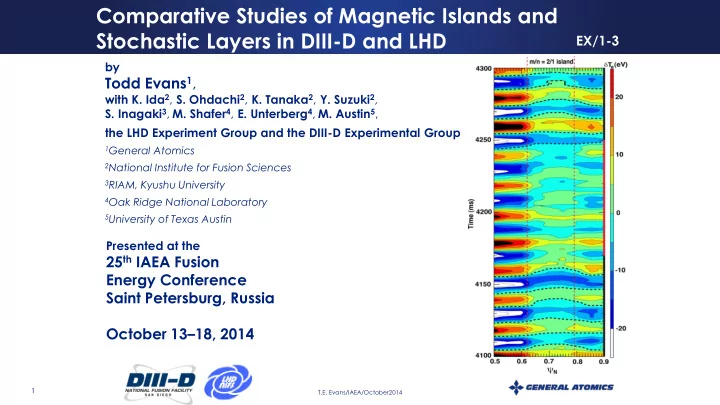

Comparative Studies of Magnetic Islands and Stochastic Layers in DIII-D and LHD EX/1-3 by Todd Evans 1 , with K. Ida 2 , S. Ohdachi 2 , K. Tanaka 2 , Y. Suzuki 2 , S. Inagaki 3 , M. Shafer 4 , E. Unterberg 4 , M. Austin 5 , the LHD Experiment Group and the DIII-D Experimental Group 1 General Atomics 2 National Institute for Fusion Sciences 3 RIAM, Kyushu University 4 Oak Ridge National Laboratory 5 University of Texas Austin Presented at the 25 th IAEA Fusion Energy Conference Saint Petersburg, Russia October 13 – 18, 2014 1 T.E. Evans/IAEA/October2014
Developing RMP ELM Control for ITER Requires an Understanding of Plasma Response to 3D Fields • MHD plasma response models predict islands, stochasticity and stable kink modes in ELM suppressed H-modes • Stable RMP driven kinks observed in DIII-D but islands and Ideal kink-like mode + stochasticity are not directly observed • Joint DIII-D and LHD L-mode experiments have provided Island with new results on the nonlinear stability of islands during: nested flux surfaces Interactions with plasma generated d B r field triggered by - stable kink mode Localized pressure perturbations due to pellets injected into - island O-points RMP = Resonant Magnetic Perturbation 2 T.E. Evans/IAEA/October2014
T e Profiles do not Provide Definitive Information on the Nature of the Plasma Response to RMP Fields • Flattening of DIII-D T e profiles during RMP not consistent with vacuum island widths • Wide T e profile flattening across q = 2 surface could result from: - An amplified m/n = 2/1 island - A partially stochastic m/n = 2/1 island - A fully stochastic layer • Additional diagnostic data needed to quantify RMP plasma response: - Modulated Electron Cyclotron (MEC) heat pulse analysis used to resolve differences 3 T.E. Evans/IAEA/October2014
Modulated EC (MEC) Heat Pulse Analysis Provides Detailed Information on Magnetic Topology • Plasma response to RMP field studied during stationary conditions (t = 3.9 to 4.35 s) • T e_ECE response at q =2 shows spontaneous bifurcations - Related to changes in m/n = 2/1 island 4 T.E. Evans/IAEA/October2014
MEC Heat Pulse Analysis Developed on LHD to Identify Magnetic Islands and Stochastic Regions • Peak in heat pulse delay time island • Flat heat pulse delay time stochastic • Transitions from islands to stochastic layers observed in LHD with changes in magnetic shear LHD Overview - OV/2-3 5 T.E. Evans/IAEA/October2014
MEC Heat Pulse Delay Time Used to Determine Island Location and Width • Fast heat pulse shunted around outside of island ( c || >> c ) • Heat pulse delay time increases at island center • Island width determined from delay time profile 6 T.E. Evans/IAEA/October2014
MEC Heat Pulse Time Delay Determines Degree of Stochasticity Around Islands • Heat pulse delay time reduced by partially stochastic island – Nested flux surface in island center increases delay time 7 T.E. Evans/IAEA/October2014
MEC Analysis Reveals Bifurcation of m/n = 2/1 Island from Nested to Partially Stochastic • Periodic bifurcations of island observed during constant RMP field - nested -> partially stochastic -> nested - Indicates importance of plasma response on island stability 8 T.E. Evans/IAEA/October2014
Stable n = 1 Kink Mode Due to RMP Field Drives Large d B r Plasma Response • Plasma n=1 d B r response: - Evolves on a transport timescale • During MEC analysis time plasma d B r is 50% of applied RMP field - Plasma n=1 d B r affects island width 9 T.E. Evans/IAEA/October2014
Proposed Scenario for Island Amplification and Bifurcation to Partial Stochasticity + Vacuum island Amplified island with nested flux with nested flux Ideal kink mode surfaces surfaces • RMP field drives stable n=1 kink mode • Kink mode produces n = 1 d B r plasma field • d B r n = 1 plasma field couples to vacuum island • Results in larger m/n = 2/1 island width • m/n = 2/1 island spontaneously bifurcates between nested and partially stochastic island 3D Physics – EX/1-1 10 T.E. Evans/IAEA/October2014
Pressure Driven Instabilities May Cause Bifurcations of Islands between Nested and Stochastic Structures • Pellets used on LHD to study pressure driven Island stability Pellet ablation profiles LHD flux surfaces • Thomson scattering profiles used to quantify island stability and transport 11 T.E. Evans/IAEA/October2014
Edge m/n=1/1 Island Stable to 60 % Increase in Pressure During Pellet Injection in LHD • No significant change in island O-point T e profile during pellet injection • Island width remains relatively constant with factor of 3 increase in n e • b inside island increases by ~ 60% • MHD modeling needed to determine internal island structure 12 T.E. Evans/IAEA/October2014
HINT2 Simulations Demonstrate Edge m/n=1/1 Island Structure is Unaltered during Pellet Injection • b island less than 2% pressure driven island stability limit 13 T.E. Evans/IAEA/October2014
Edge m/n = 1/1 Magnetic Island Inhibits Inward Transport of Pellet Particles in LHD Density evolution during pellets in LHD Magnetic island (with RMP) at r = 0.5 – 0.6 • Pellet particles localized to edge region with RMP field R eff (m) Electron density - Relatively small inward pellet mass redistribution pellets • Without islands pellet mass No magnetic island (without RMP) spreads over larger edge region - Inward particle transport R eff (m) Electron density between pellets is much larger LHD Overview - OV/2-3 pellets 14 T.E. Evans/IAEA/October2014
Results and Conclusions • Joint DIII-D and LHD experiments have demonstrated that the plasma response to the RMP field must be included to understanding the physics of ELM suppression - In DIII-D plasma response to n=1 RMP field increases island width and causes spontaneous bifurcations of the internal island topology - In LHD the topology of an edge island is unaffected by a 60% increase in b and inward particle transport is inhibited 15 T.E. Evans/IAEA/October2014
Recommend
More recommend